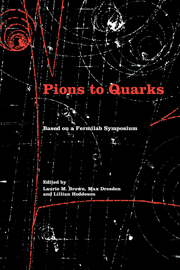Book contents
- Frontmatter
- Contents
- List of contributors
- Foreword by Leon M. Lederman
- Editors' acknowledgments
- Photographs of the symposium
- List of abbreviations
- List of notation
- I Introduction
- II Particle discoveries in cosmic rays
- III High-energy nuclear physics
- IV The new laboratory
- 9 The making of an accelerator physicist
- 10 Accelerator design and construction in the 1950s
- 11 Early history of the Cosmotron and AGS at Brookhaven
- 12 Panel on accelerators and detectors in the 1950s
- 13 Accelerators and the Midwestern Universities Research Association in the 1950s
- 14 Bubbles, sparks, and the postwar laboratory
- 15 Development of the discharge (spark) chamber in Japan in the 1950s
- 16 Early work at the Bevatron: a personal account
- 17 The discovery of the antiproton
- 18 On the antiproton discovery
- V The strange particles
- VI Weak interactions
- VII Weak interactions and parity nonconservation
- VIII The particle physics community
- IX Theories of hadrons
- X Personal overviews
- Name index
- Subject index
9 - The making of an accelerator physicist
Published online by Cambridge University Press: 07 May 2010
- Frontmatter
- Contents
- List of contributors
- Foreword by Leon M. Lederman
- Editors' acknowledgments
- Photographs of the symposium
- List of abbreviations
- List of notation
- I Introduction
- II Particle discoveries in cosmic rays
- III High-energy nuclear physics
- IV The new laboratory
- 9 The making of an accelerator physicist
- 10 Accelerator design and construction in the 1950s
- 11 Early history of the Cosmotron and AGS at Brookhaven
- 12 Panel on accelerators and detectors in the 1950s
- 13 Accelerators and the Midwestern Universities Research Association in the 1950s
- 14 Bubbles, sparks, and the postwar laboratory
- 15 Development of the discharge (spark) chamber in Japan in the 1950s
- 16 Early work at the Bevatron: a personal account
- 17 The discovery of the antiproton
- 18 On the antiproton discovery
- V The strange particles
- VI Weak interactions
- VII Weak interactions and parity nonconservation
- VIII The particle physics community
- IX Theories of hadrons
- X Personal overviews
- Name index
- Subject index
Summary
“Go west …”
As the decade of the 1950s began, there was still no accelerator with an energy as high as 1 GeV. Still, the stage was set for an almost explosive development. The new principle of phase-stable acceleration, proposed by Vladimir Veksler and Edwin McMillan in 1945, had already been put to use in a large proton-synchrocyclotron at Berkeley (600 MeV) and in a rash of electron-synchrotrons with energies near 300 MeV. Indeed, by 1950, the first two large proton-synchrotrons were under construction: the 3-GeV Cosmotron at the Brookhaven National Laboratory, and the 6-GeV Bevatron at the Berkeley Radiation Laboratory.
These developments were, however, of little personal concern to me. I was, at the time, a young faculty member at the Massachusetts Institute of Technology, working on cosmic-ray research in the laboratory of Bruno Rossi. However, early in 1950, I began to give a little thought to the possibility of switching at least part of my research to particle physics, using the recently completed MIT electron-synchrotron.
Such thoughts were brusquely terminated in April of that year, when I was forced, on one day's notice, to abandon my position at MIT and flee the state of Massachusetts to avoid legal prosecution by an irate former wife. A day later I found myself in New York City without money or job, and with quite an uncertain future.
Fortunately, during World War II, I had become something of an expert in the design of electronic instruments (under the tutelage of Joseph Kiethley at the Naval Ordnance Laboratory and of William Higinbotham at the Los Alamos Laboratory), and that knowledge now came to my rescue.
- Type
- Chapter
- Information
- Pions to QuarksParticle Physics in the 1950s, pp. 149 - 161Publisher: Cambridge University PressPrint publication year: 1989
- 1
- Cited by



